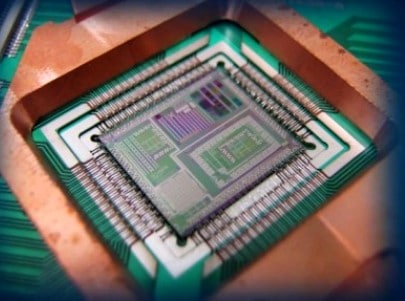

On last week’s edition of BBC Radio 4’s Material World, Geordie Rose, founder and Chief Technology Officer of D-Wave Systems, discussed the potential of quantum computing.
The computers that you know, which function on one and zeroes, may be replaced one day by a device making use of the mysterious “qubit” which can, rather mind-bendingly, be both one and zero at the same time, and in so doing can solve problems at approximately 3,600 times the speed of the very best currently available computer.
Flying in the face of skepticism posed by various scientists over the last few years, who have pointed out the unfeasibility, if not the impossibility, of making an actual quantum computer, the Burnaby-based company has just sold a 512 qubit D-Wave Two model to NASA and Google for approximately $15 million. The computer will reside at NASA’s Ames Research Facility in Silicon Valley, and will be used in the development of artificial intelligence, among other things.
Simultaneously acknowledging and dismissing his critics, Rose speaks of his computer as using “quantum effects” and employing “quantum phenomena”. A panelist on the Radio 4 show, not bothering to conceal his evident excitement over the computer’s existence, nevertheless describes D-Wave’s machine as something that “both is and isn’t a quantum computer”.
The skepticism arises from D-Wave’s eschewing of the standard “gate model” of quantum computing, which is what most academics insist is the only feasible way forward. In the Radio 4 interview, Rose outlines the difference between standard theoretic quantum computing and his “adiabatic” model, “If you want to go to the moon, the gate model is kind of like if you want to build a ladder to the moon. There may not be any basic physical laws that say you can’t build a ladder to the moon, but if your objective is to get to the moon, why don’t you build a rocket?”
Colin Williams, director of business development and strategic partnerships at D-Wave, talked about the potential value of ownership of the D-Two for NASA. “Examples today include using supercomputers to model space weather, simulate planetary atmospheres, explore magnetohydrodynamics, mimic galactic collisions, simulate hypersonic vehicles, and analyze large amounts of mission data.”
To most of the criticism directed at D-Wave’s efforts from theorists and academic circles, Rose responds, “We prefer the results that come out of the lab as guidance, rather than the beauty of the underlying theory.” The purchase by Google and NASA will also give access to researchers affiliated with the Universities Space Research Association, which seems like something of an endorsement by academia after all the years of skepticism. “We try to discard dogma and follow the experimental evidence that everybody has available to them,” says Rose.
The deal with NASA and Google follows a 2011 sale of a 128 qubit D-Wave One to military contractor Lockheed Martin.
With the inauguration earlier this year of Mike Lazaridis’ Quantum Valley research facility in Waterloo, is Canada now the de facto world leader in quantum computing?
Leave a Reply
You must be logged in to post a comment.


 Share
Share Tweet
Tweet Share
Share




Comment